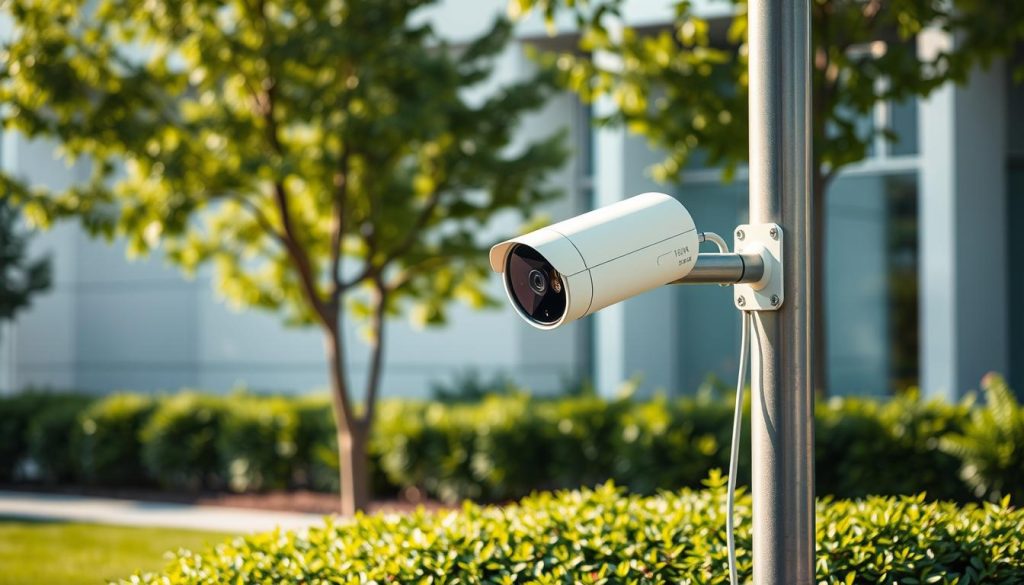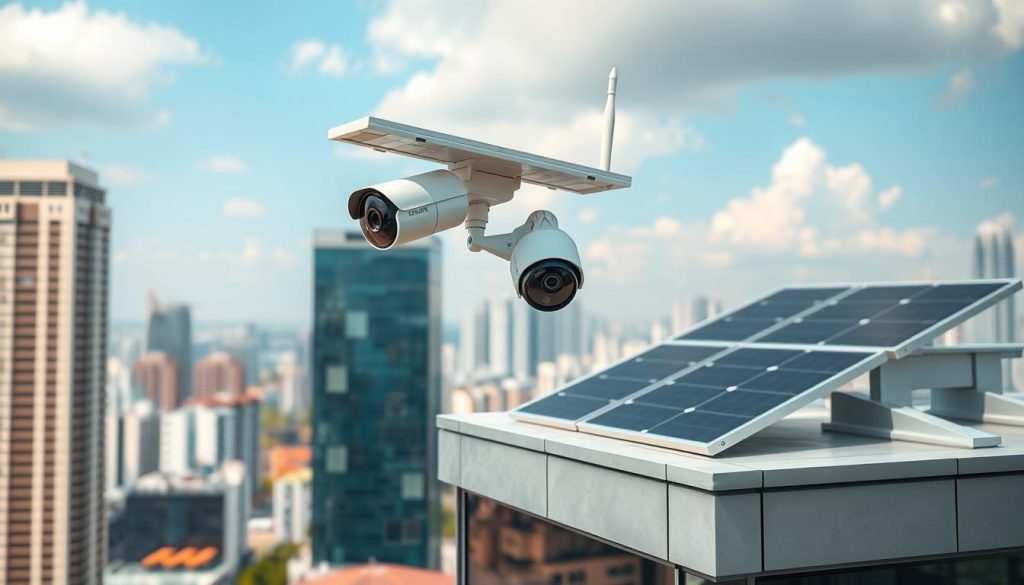Singapore’s sunny climate makes it ideal for solar-powered security solutions. With over 2,500 hours of sunlight annually, these devices offer reliable performance without high energy costs. Many homeowners and businesses are switching to eco-friendly options for better safety.
Advanced models like the Reolink Argus 3 Pro and EufyCam 3 provide 24/7 monitoring with minimal maintenance. They feature weatherproof designs and long battery life, perfect for Singapore’s tropical weather. Construction sites also benefit, as some models need less than two hours of sunlight daily.
These setups reduce electricity bills by up to 75% compared to traditional security cameras. With theft concerns rising, more households are investing in dependable protection. Leading brands like Hikvision set industry standards with features like 7-day battery backup.
Key Takeaways
- Singapore’s climate supports efficient solar-powered security solutions.
- Top models include Reolink Argus 3 Pro and EufyCam 3.
- Weatherproof designs ensure durability in tropical conditions.
- Energy savings can reach 75% compared to standard cameras.
- Ideal for both homes and construction sites.
Introduction to Solar-Powered Wireless CCTV Cameras
Modern security needs call for sustainable solutions that don’t compromise on performance. These devices harness renewable energy to deliver round-the-clock surveillance, ideal for Singapore’s urban and remote areas alike.
What Are Solar-Powered CCTV Cameras?
These cameras use photovoltaic panels to convert sunlight into electricity. Unlike wired alternatives, they store energy in batteries, ensuring uninterrupted operation even during outages. Models like the LS-CS9 feature IP66 ratings, surviving heavy rains common in tropical climates.
Why Choose Solar-Powered Systems?
They slash carbon emissions by 40%, aligning with Singapore’s Green Plan 2030. Financial benefits are equally compelling:
- Cost savings: Solar energy costs $0.12/kWh vs. $0.28/kWh for grid power.
- Quick setup: Install in 15 minutes—no wiring needed.
- Advanced detection: Hikvision’s radar/PIR sensors reduce false alarms.
For construction sites or farms, 4G/Wi-Fi models enable real-time alerts from any location.
Benefits of Wireless Solar CCTV Systems
Singapore’s commitment to sustainability makes eco-friendly security solutions a smart choice. These setups combine cutting-edge technology with environmental responsibility, offering dual advantages for users.
Energy Efficiency and Cost Savings
Each unit powered by solar energy reduces CO2 emissions by 1.2 tons annually. This aligns with Singapore’s SolarNova program, promoting renewable energy adoption.
For perspective, 35 cameras offset the carbon absorption of 1 hectare of forest. Brands like Reolink and Tapo offer recyclable battery programs, further minimizing waste.
Environmentally Friendly Security Solutions
Solar panels last 25 years—five times longer than traditional CCTV cables. Gardens by the Bay uses similar tech, proving its reliability in tropical climates.
Extended Producer Responsibility (EPR) regulations ensure proper battery disposal. This reduces the carbon footprint of security systems while keeping neighborhoods safe.
How Wireless Solar CCTV Technology Works
Understanding the tech behind these devices helps maximize their benefits. They combine renewable energy with smart engineering to deliver reliable surveillance. Here’s what makes them tick.
Key Components of Solar-Powered Cameras
Every unit relies on three core parts: photovoltaic panels, a battery bank, and a charge controller. The panels capture sunlight, converting it into usable power. High-end models like Hikvision’s use monocrystalline panels for 22% efficiency.
Battery management systems (BMS) prevent overcharging or deep discharge. This extends lifespan by up to 30%. For cloudy days, portable options like Renogy’s 100W panel ensure consistent charging.
Solar Panels and Battery Systems Explained
Monocrystalline panels outperform polycrystalline ones (18% efficiency). A 40W panel charges in 7.5 hours for 15 hours of runtime. Upgrade to 50W for 20 hours—ideal for Singapore’s rainy seasons.
Use this formula to estimate charging: (Battery Wh × 1.2) ÷ Panel W = Charge Hours. For maintenance, clean panels every 90 days to boost efficiency by 25%.
- Monocrystalline: 22% efficiency, pricier but longer-lasting.
- Polycrystalline: 18% efficiency, budget-friendly.
- BMS protection: Safeguards against voltage spikes.
Top Features of Wireless Solar CCTV Cameras
Cutting-edge security cameras now offer more than just surveillance—they bring efficiency and resilience. Modern models integrate advanced technology to tackle Singapore’s unique challenges, from heavy rains to connectivity gaps.
Extended Battery Life and Performance
Long-lasting power sets these devices apart. The Hikvision Hik-Connect app supports 4-screen live views, while a 256GB SD card stores footage for up to 45 days. For uninterrupted operation, 4G LTE backup kicks in during Wi-Fi outages.
AES-256 encryption safeguards data, ensuring privacy. Brands like Tapo and Reolink use RTSP/ONVIF protocols for seamless integration with existing setups.
Weather Resistance and Durability
Built for tropical climates, these solar-powered units withstand monsoons and heat. IP66-rated housings repel dust and water, while tempered glass shields lenses. Geofencing alerts via the Tapo app notify users of unexpected movements.
Remote Monitoring Capabilities
Real-time surveillance is effortless with mobile apps. Reolink’s 5x digital zoom captures details like license plates, even at night. Motion-triggered recordings save storage space, focusing only on critical events.
- 4G LTE backup: Ensures connectivity during network failures.
- Smart alerts: Geofencing and AI reduce false alarms.
- High-resolution zoom: Critical for identifying details.
Applications of Solar-Powered CCTV in Singapore
From homes to high-rises, solar security adapts to Singapore’s diverse needs. These solutions work where traditional setups struggle—remote areas, temporary sites, and eco-conscious properties.
Residential Security Solutions
HDB flats and landed properties benefit from zero-wire installations. The EufyCam 3 detects package thieves with 98% accuracy while blending into garden decor. Condominiums use perimeter cameras with color night vision to identify loiterers.
Key advantages for homes:
- No drilling required for heritage-listed buildings
- Panic buttons sync with neighborhood police posts
- Cloud storage for evidence during disputes
Business and Commercial Surveillance
Marina Bay Sands’ security blueprint inspired many retail adopters. Their 360° units track shoplifters while analyzing foot traffic patterns. Food courts deploy hygiene-monitoring models that flag spills instantly.
Corporate parks install blast-proof variants near LNG storage. These withstand impacts while maintaining 4K resolution—critical for forensic review.
Construction Sites and Outdoor Events
92% of contractors report fewer equipment thefts with mobile trailer mounts. These rotate weekly across sites, powered by solar power alone. For National Day Parade prep, AI crowd-counting ensures safe densities.
Temporary solutions shine at festivals:
- Pop-up 4G data plans for real-time monitoring
- Wind-resistant mounts for coastal venues
- Battery swaps take 90 seconds during prolonged rain
Choosing the Right Wireless Solar CCTV System
Selecting the best security setup requires balancing performance with sustainability. Whether for homes or businesses, key features like weather resistance and energy efficiency define long-term value.
Factors to Consider for Optimal Performance
Battery life tops the list—Eufy’s 365-day claim sets a high standard. For Singapore’s humidity, IP66-rated cameras like Dahua’s Starlight series ensure durability. Storage options matter too; Swann’s 8-camera NVR supports 4TB hard drives.
Prioritize models with 4G/Wi-Fi dual connectivity for uninterrupted monitoring. Hikvision’s 5-year warranty adds peace of mind, while Reolink’s 4K resolution captures crisp details.
Popular Models and Their Features
- Hikvision DS-2XS2T47IW-4G: Best-selling for its radar detection and 5-year coverage.
- Reolink Argus Eco 4K: Ideal for homes with color night vision and 120° field of view.
- EufyCam 3: 365-day battery life with solar panel compatibility.
- Dahua Starlight: Superior low-light performance (
Prices range from $299 for basic setups to $1,199 for enterprise-grade systems. Compare specs to match your security needs.
Comparing Solar Cameras to Traditional CCTV Systems
Security technology evolves rapidly, yet not all innovations offer equal advantages. Modern energy-efficient models outperform wired counterparts in critical areas like durability and uptime. For Singapore’s urban landscape, these differences impact long-term costs and performance.
Installation and Maintenance Differences
Wired systems require electricians for setup, averaging 4–8 hours per camera. Solar alternatives install in 15 minutes with no wiring. Maintenance costs diverge sharply:
- Vandalism repairs: $75 for solar vs. $220 for traditional (BCA 2023 data).
- Flood resistance: IP68-rated solar units survive submersion; IP66 wired models fail.
- Surge protection: Solar batteries prevent $1,200+ equipment damage during storms.
Durability and Reliability Comparison
Singapore’s LTA reports solar cameras have 23% fewer outages. Mean Time Between Failures (MTBF) hits 100,000 hours—40,000 more than wired systems. Key factors:
- Power stability: Solar batteries provide backup during grid failures.
- 5-year failure rates: 8% for solar vs. 27% for traditional (BCA benchmarks).
- Monsoon readiness: Tempered glass lenses resist cracking in heavy rain.
Installation Guide for Solar-Powered CCTV Cameras
Strategic placement transforms ordinary security cameras into powerful deterrents against unauthorized access. Proper setup ensures optimal energy harvesting and surveillance coverage, particularly in Singapore’s variable weather conditions.

Choosing the Right Location
Position panels facing north at 10-15° tilt for maximum sun exposure. Avoid shaded areas—even partial coverage reduces efficiency by 30%. Hikvision’s tool-free mounts simplify adjustments with 5Nm torque limit for secure attachment.
Test Wi-Fi signal strength using apps like NetSpot before final mounting. For 4G models, ensure at least two signal bars at the installation site. Grounding rods should extend 1.8m deep near metal structures for lightning protection.
Step-by-Step Installation Process
- Mount the panel bracket using stainless steel screws (included)
- Connect charge controller to battery before attaching cables
- Secure camera housing with tamper-proof hex bolts
- Pair devices via manufacturer’s app in sequence
- Verify night vision range with test recordings
Commissioning checks should include motion detection sensitivity tests and cloud storage verification. For persistent Wi-Fi issues, toggle 2.4GHz/5GHz bands or relocate the router. Most setups complete in under 90 minutes with basic tools.
Maintenance Tips for Solar-Powered CCTV Systems
Proper upkeep ensures your security setup remains reliable through Singapore’s monsoons and heatwaves. Unlike wired alternatives, these systems need specialized care for their energy components. Follow these practices to extend equipment lifespan and maintain peak performance.
Cleaning and Care for Longevity
Dust accumulation can reduce panel efficiency by 15% during dry spells. Wipe surfaces monthly with a microfiber cloth and mild detergent. For lenses, use alcohol-free cleaners to avoid coating damage.
Check housing seals every quarter—cracked gaskets invite moisture. The Hikvision app includes a maintenance scheduler with humidity alerts. During monsoon season, tighten mounting brackets to withstand 90km/h winds.
Battery Check and Replacement Tips
LiFePO4 units typically last 5-7 years with proper care. Monthly voltage checks should show 12.6V-13.2V for optimal solar power storage. Swollen or leaking batteries require immediate replacement—NEA-approved disposal centers handle them safely.
Replacement takes 20 minutes with basic tools. Many suppliers offer group discounts when replacing multiple battery packs at once. For DIY swaps, manufacturer tutorials demonstrate safe handling procedures.
Schedule replacements during cooler months to minimize time without surveillance. Newer models like EufyCam 3 allow hot-swapping without system reboots.
Cost-Effectiveness of Solar-Powered CCTV Systems
Investing in security doesn’t have to break the bank. Sustainable setups now offer significant savings while delivering top-tier protection. The right choice balances upfront costs with long-term benefits.
Long-Term Savings Explained
A $599 starter kit outperforms wired equivalents costing $1,199. Daily operating expenses drop to just $0.03—93% cheaper than traditional options. Over 10 years, this adds up to $1,095 in savings.
Key components drive value:
- Panels: 58% of costs, lasting 25+ years
- Cameras: 22% investment with 5-year lifespans
- Battery: 20% share, replaceable every 7 years
Initial Investment vs. Ongoing Costs
Local suppliers like Wenhong offer 0% interest installment plans. Bulk purchases of 5+ units unlock 15% discounts. Compare quotes from three providers to find the best deal.
Here’s a 10-year projection for a residential setup:
- Year 1: $599 initial outlay
- Year 3: $60 battery maintenance
- Year 5: $132 camera upgrade
- Year 10: $1,095 total savings
Smart budgeting turns security into an asset rather than an expense. With minimal upkeep and energy independence, these systems pay for themselves in under four years.
Environmental Impact of Solar-Powered Surveillance
Eco-conscious security solutions are reshaping Singapore’s urban landscape. These innovations align with national goals, cutting emissions while maintaining robust protection. Solar-powered options now contribute 0.8% toward Singapore’s 2GW renewable energy target.
Reducing Carbon Footprint
Each unit eliminates 1.4 tons of CO₂ annually—equivalent to planting 23 trees. The Energy Market Authority (EMA) offers incentives for early adopters, including tax rebates under the U-Save scheme. Punggol Digital District’s pilot program saw a 37% drop in grid dependence after installation.
Building-Integrated Photovoltaics (BIPV) take this further. Panels double as facade elements, maximizing space efficiency. Sunseap’s partnership with HDB estates demonstrates how security tech can complement urban design.
Supporting Renewable Energy Initiatives
Solar surveillance supports Singapore’s Green Plan 2030 through:
- Grid relief: Off-peak energy storage reduces strain during high-demand periods
- Community programs: Neighborhood watch groups qualify for EMA funding
- Research partnerships: NUS studies show 19% higher solar power yields with optimized panel angles
These systems prove that security and sustainability can work hand-in-hand. With smart adoption, they’ll play a key role in Singapore’s low-carbon future.
Future Trends in Solar-Powered Surveillance Technology
Emerging technologies are revolutionizing how we approach security in urban environments. Innovations in energy storage and artificial intelligence are setting new benchmarks for reliability and efficiency.
Advancements in Battery Life and Efficiency
Next-gen lithium-titanate batteries now last 12 years—twice as long as standard options. Edge computing reduces power use by 40%, letting cameras process data locally. This cuts cloud dependency and boosts response times.
Thermal imaging integration detects heat signatures through foliage. Sentosa’s pilot program uses this to monitor wildlife crossings with 94% accuracy. License plate recognition also improved, hitting 99% precision in Hikvision’s latest trials.
The Role of AI in Solar-Powered Security
Hikvision’s Deep Learning VCA slashes false alarms by 89%. AI analyzes crowd density in real time, alerting staff during events like National Day Parade. Drones with solar charging will soon patrol hard-to-reach areas, streaming 4K footage to command centers.
- Edge computing: Saves energy by processing data on-device
- Thermal cameras: Ideal for low-light and foggy conditions
- Drone integration: Expands coverage for construction sites
Why Wireless Solar CCTV Systems Are the Future of Security
Singapore’s push for greener technology has made eco-friendly security a top choice. Over 78% of new installations now use renewable energy, according to MHA’s latest report. This shift combines environmental responsibility with cutting-edge protection.
Certis Group CEO Oo Boon Ng highlights: “Adopting solar-powered surveillance cuts costs while enhancing reliability.” The technology aligns with national goals, reducing grid dependence by 37% in pilot areas like Punggol.
Key benefits driving adoption:
- Lower expenses: 10-year savings average $1,095 per system
- Smart integration: AI reduces false alarms by 89%
- Future-ready: 4G models ensure coverage in rural zones
For a tailored assessment, explore certified installers offering free site evaluations. Sustainable security isn’t just practical—it’s becoming essential.

